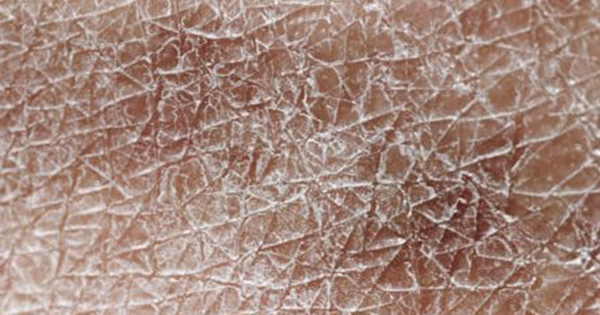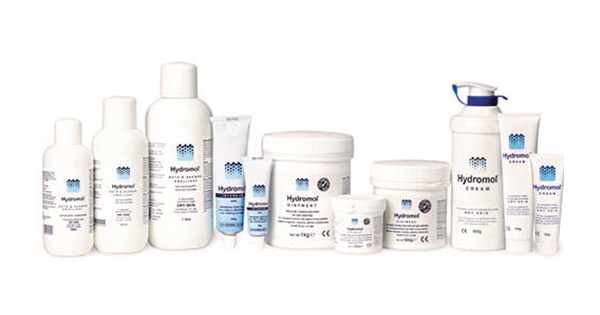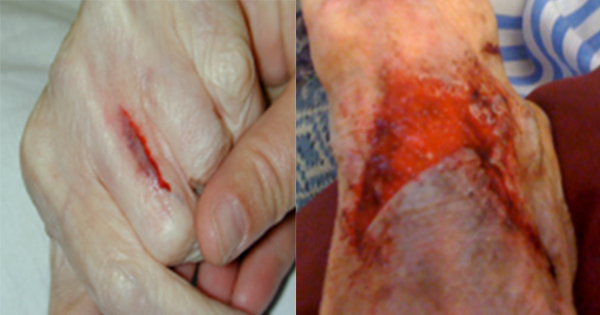Healthcare advances have led to a significant increase in the aged population in the UK, which while positive also causes concern for how the National Health Service (NHS) will sustain high standards of care alongside growing demand (Ferguson and Belloni, 2019). When the NHS was founded in 1948, the average life expectancy was 66 years for men and 70 years for women (Hawe, 2008). Presently, life expectancy has increased to 79 years for men and 82.9 years for women (Office for National Statistics, 2021).
Skin fragility (also referred to as dermatoporosis) due to ageing, specifically in those over 65 years old, reduces the resilience of skin when faced with trauma and injury (Kaya et al, 2019). In turn, this can exacerbate the incidence of pressure ulcers (PUs) and skin tears (STs) in older people (Jaul et al, 2018; Serra et al, 2018). Furthermore, those who are dependent on others for skin care, e.g, persons nursed in bed, with reduced mobility or ability, are also at higher risk of PUs and STs (Kottner et al, 2019).
Additional considerations to support skin integrity
Hydration and nutrition
Hydration and nutrition can impact the durability of the skin to withstand injury in old age; underweight patients have been found to be at higher risk of PUs (Kottner et al, 2011). The epidermis is the outermost layer of the skin and acts as a protective barrier (Cleveland Clinic, 2022). Healthy, hydrated epidermal cells are made up of roughly 70% water, which offers an effective layer of cushioning to protect the skin (Akdeniz et al, 2018). Dehydration leads to xerosis and reduced elasticity in the skin, increasing risk of damage (University Hospitals Coventry and Warwickshire NHS Trust, 2024). In a UK study, it was found that 37% of over 65 year olds admitted to hospital were systemically dehydrated (El-Sharkawy et al, 2015). It is difficult to determine if dehydration is the cause or result of illness; however, dehydration is associated with poorer health outcomes (Briscoe, 2018; Association of UK Dietiticians, 2019).
Health literacy and health promotion
Health literacy levels have a great impact on health outcomes, with one in three older adults having sub-standard understanding of health information, which is linked to higher mortality rates (Bostock and Steptoe, 2012). This reiterates the importance of the provision of health education to patients and their families/carers, to allow them to understand the fundamentals of a healthy lifestyle, and live healthier for longer. Furthermore, it is important that nurses are actively providing education to people in their care to improve these outcomes as stated in section 9 of the Nursing and Midwifery Council code, “Share your skills, knowledge and experience for the benefit of people receiving care and your colleagues” (Nursing and Midwifery Council, 2018). It must also be noted that despite the input of healthcare professionals, access to health promotion in the NHS is limited; despite calls for health promotion policies which have the potential to improve health outcomes, while simultaneously relieving pressure on the NHS (McKee et al, 2021). By way of example, a recent study identified very little evidence to show that current patient and carer educational interventions have any impact on reducing the incidence of PU (O’Connor et al, 2021); despite findings that PUs have a detrimental impact on physical, social, psychological, financial and overall quality of life (Gorecki et al, 2009).
The importance of informing patients and carers has now been highlighted in the updated version of the SKINN bundle, the aSKINNg framework (NHS Improvement, 2021):
- Assess risk
- Skin assessment
- Surface selection and use
- Keep patients moving
- Incontinence assessment and care
- Nutrition and hydration assessment/support
- Give information
This tool adopted by healthcare institutions across the globe aims to aid the prevention and management of PUs. The newly incorporated ‘Give information’ section acknowledges the importance of informing patients/carers and colleagues about pressure ulcer prevention strategies (NHS Improvement, 2021).
Skin-protecting equipment
Beyond effective assessments there is a variety of different equipment and treatments available to manage PU prevention, including, but not limited to, pressure-relieving mattresses, pressure-relieving seat cushions and heel-elevating boots (Oxford Health NHS Foundation Trust, 2015). Furthermore, there are several preventative strategies to reduce the risk of STs, for example, the International Skin Tear Advisory Panel (ISTAP) recommend reducing risk of shear and friction with correct use of manual handling aids, for example, hoist and slide sheet (ISTAP, 2018). Furthermore, ISTAP discussed that risk assessments are advised to identify delirium, falls risk and using the results to aim for a safer environment to reduce injury. This could include removing unnecessary clutter or improved lighting for example. ISTAP recommendations also relate to the use of cushioning where appropriate to create a barrier between fragile skin and harsh surfaces (ISTAP, 2018).
Emollient application
The terms moisturiser and emollient are often used synonymously despite a debate regarding the actions of these products (Newton, 2021). The NHS defines emollients as moisturising skin treatments for the purpose of hydrating and soothing (NHS, 2020a). Therefore, the term ‘emollient’ will be used for the purposes of this review.
Xerosis is a common consequence of ageing and refers to a deficiency of water in the stratum corneum, the skin barrier layer (Moncrieff et al, 2018). The stratum corneum is made up of corneocytes encased in intracellular lipids and filled with a natural moisturising factor, which draws in and holds water in the cells (Moncrieff et al, 2018). Emollients and emulsion-based creams are used to hydrate, moisturise and reduce skin breakdown (NICE, 2022a) by creating a non-physiological oil layer over the skin to reduce water loss from the stratum corneum (Brooks et al, 2017). The connection between xerosis and the incidence of PUs and STs is well documented (Minematsu et al, 2021; NHS, 2020b), with an appropriate intervention to manage xerosis being the application of emollients (Purnamawati et al, 2017). Yet, evidence suggests that despite PUs costing the NHS £3.8 million per day and the NHS stating that PU prevention is of utmost priority (NHS improvement, 2018), the NHS is overlooking the importance of health promotion of simple preventative treatments, such as emollient application. Skin health in the older population is being disregarded from their ‘A practical guide to healthy aging’ document (NHS, 2019).
Furthermore, the NHS online guide for carers providing hygiene, does not mention emollient application, despite discussing bed baths for immobile persons, likely to be at higher risk of PU and ST (NHS, 2024). This demonstrated the importance of the relationship between person-centred care (PCC)/family-centred care (FCC) and health promotion/education in relation to PU and ST prevention.
Person- and family-centred care
The concept of PCC was first established in the 1950’s with the term ‘client-centred care’ being used to define tailored care, rather than generalised care catering to the stereotypes of illnesses (The Health Foundation, 2016). The significance of PCC in the nursing profession is reflected in various guidance and government acts (Nursing and Midwifery Council, 2018; Health and Social Care Act, 2008). Involving patients in individualised care planning has many social, mental and financial benefits; empowerment improves concordance, self-care and, in turn, can reduce the burden on the NHS (NHS England, 2017). Older studies found that barriers towards the success of PCC include the inconsistency of priorities across different healthcare professions, as well as staff shortages (Morris, 2007). In recent years, there has been a strong focus on creation of local policies and care models, including the House of Care Model and PCC toolkits to encourage collaboration and promote a more successful PCC approach (The Health Foundation, 2016).
The involvement of families in patient care, sometimes referred to as FCC, has been criticised, with differences of opinion said to cause friction and inhibit decision-making (Jazieh et al, 2018). Strategies that facilitate involvement have been found to improve FCC while also protecting patient’s autonomy (Wiig et al, 2020).
Person- and family-centred care to support skin integrity
If an individual acquires a PU within a healthcare setting, they are more likely to have extended hospital admissions, as well as an increased risk of mortality (Office for Health Improvements and Disparities, 2022). The successful delivery of PCC results in the best possible outcomes for patients (The Health Foundation, 2016). Furthermore, supporting family/carers to implement preventative initiatives beyond the hospital ward is advantageous in maintaining patient health and reducing hospitalisations (Collins, 2018). The importance of staff education was emphasised in effective treatment delivery, with training provided on the correct method of emollient application in most of the studies discussed below (Carville et al, 2014; Finch et al, 2018; Diaz-Valenzuela et al, 2019; Lechner et al, 2019).
Therefore, it is not amiss to assume the same education is required for patients and their families. Lack of knowledge is shown to be a barrier to the provision of preventative skin care (Moncrieff et al, 2015, Harries and Begg, 2016) and the participation of patients and/or carers in their care is integral, when considering preventative treatments, such as emollient application (Moncrieff et al, 2015). Understanding the significance of PCC and FCC in regular emollient application is key when promoting ST and PU prevention.
The skin changes that occur later in life include fragility, dryness and slower healing rates (Ludmann, 2021). Incorporation of the use of emollients into skincare routines, particularly when skin is still damp from washing, would help to retain moisture and rebuild the skin’s protective barrier (Ludmann, 2021).
Evidence to support the use of emollient therapy
Emollient therapy and pressure ulcer prevention
Lechner et al (2017) completed a descriptive, cross-sectional, prevalence study on the link between xerosis and PU risk. In 3,837 residents and patients across 30 nursing homes and 13 hospitals across Germany, the results showed a connection was found between xerosis and PU prevalence when associated with PU in the heels and feet, but not in the sacral region (P>0.001). Furthermore, findings demonstrated that PUs were more prevalent in hospitals in comparison to nursing homes.
Diaz-Valenzuela et al (2019) determined the relationship between the application of olive oil and the prevention of PUs in the heels, sacrum and gluteus. The non-inferiority, multicentre, randomised, controlled, and double-blinded clinical trial study, comprised 571 residents across 23 nursing homes in Spain. The absence of adverse reactions in this study deemed topical olive oil solution a safe and effective option for the prevention of PUs. While the study by Diaz-Valenzuela et al (2019) found equal efficacy of olive oil and the recommended Spanish clinical practice guideline product hyper-oxygenated fatty acids at preventing PUs, they also discuss how the hydrating and protective properties of olive oil application can also prevent skin peeling and STs (Diaz-Valenzuela et al, 2019). Despite findings from Nasiri et al (2015) showing that oleic and linoleic acids found in olive oil pose healing benefits when applied to pre-existing diabetic foot ulcers (P>0.001). There is no information about the efficacy of using olive oil on pre-existing PUs.
It is important to note that Diaz-Valenzuela et al (2019) did not discuss the associated fire risks posed by using oil-based emollient. Consideration should be made to the absorption of applied oil into bedding and clothing, as well as flammability when exposed to concentrated gases (oxygen) that are present in healthcare settings and some homes (North Yorkshire Clinical Commissioning Group, 2022).
Lechner et al (2019) undertook an exploratory study in 1,486 hospital patients and 1,662 nursing home residents across an undisclosed number of facilities across Germany. The authors discussed the use of topical skin care products and the prevalence of xerosis in these facilities. Interestingly, incidence of xerosis in skin care-dependent participants was 70.2% compared to 55.2% of independent participants. Furthermore, xerosis itself was the main indicator for the application of emollient as opposed to emollient being standard daily practice (Lechner et al, 2017).
The findings of PUs being more prevalent in hospitals in comparison to nursing homes (Lechner et al, 2017) links to other research stating hospitalisation can contribute to increased risk of PUs (Jaul et al, 2018). This could be associated with the findings by Lechner et al (2019) that xerosis was more prevalent in the hospital setting and that the application of leave-on emollient was significantly higher in nursing home settings. Equally there are greater contributing factors, such as condition and acuity.
Emollient therapy and skin tear prevention
Carville et al (2014) prospectively explored the impact of twice daily application of an unnamed pH neutral (pH 5–6), perfume-free, emollient by Abena® in a cluster randomised control trial. The study found that following this regimen reduced the incidence of STs by almost 50% (from 252 STs in the control group to 172 STs in the intervention group) in 424 residents of 14 different aged care facilities in Australia. The majority of STs occurred in the upper limbs with no significant difference between anatomical locations in control or intervention groups (P>0.05).
In a prospective interventional study, Finch et al (2018) explored the connection between twice-daily emollient application (QV Skin Lotion, Ego™ Pharmaceuticals) and reduction of STs in older patients in a private hospital in Australia. The sample included 762 participants, which was compared to a historical (data from previous years) control (n=415). The authors concluded that twice-daily application of an emollient to the extremities of the aged reduces ST incidence from 6.61 (per 1000 beds) in the control group, to 4.35 (per 1000 beds) in the intervention group (P=0.006).
Both Carville et al (2014) and Finch et al (2018) found a relationship between the application of an emollient and the reduction of incidence of STs, which, in the case of Carville et al (2014), influenced guidance on patient skincare, in the Australian state of Victoria, as prior to this there were not specific guidelines in place for emollient application (Victoria State Government Department of Health, 2015). Carville et al (2014) acknowledge a limitation to their study being that it comprised of mainly elderly Caucasians. It was also undertaken in a country with higher levels of sun exposure, which is important to consider as UV rays have been shown to damage the mechanical and structural properties of the stratum corneum (Lipsky and German, 2019). Therefore, further research is required to determine the impact of emollient application to prevent STs in more temperate climates (UK) and in those with different skin tones.
Emollient therapy and general skin care
A UK randomised educational study by Harries and Begg (2016) examined the impact of providing education on the use of TENA® non-rinse cleanser (emulsion-based cream) with regards to moisture lesion and PU prevention across five clinical areas. The results showed a 74% reduction in skin damage in the genital and buttock areas when the use of the cream and education was provided as to the recommended use of the product. It was found that some participants in the non-education group added the wash cream to a warm bowl of water, although it is designed to be applied directly to the skin and residual cream wiped, not rinsed. This study acknowledges the influence of financial culture on staff, as they were reluctant to use the ‘costly’ skin-protecting products. Smaller dispenser sizes were preferable to reduce waste created by short-stay patients. Furthermore, they highlighted that emollients are only effective if they are used correctly, requiring application education (Harries and Begg, 2016). Defloor et al (2005) state that moisture lesions are often mistaken for PUs due to a lack of education. As their treatments differ greatly, this highlights again the importance of education associated with caring for vulnerable skin.
Brooks et al (2017) conducted a quasi-experimental pilot study in the UK, which included 10 aged healthy participants to examine the effect of skin cleansing and emollients on lower legs of elderly women. The authors determined that low-cost skin care regimens, such as 2% glycerine soak and Vaseline™, appeared to improve hydration of the stratum corneum (measured using a Vapometre™ for transepidermal water loss measurement, from -0.66 gH2O/m2/h in the control group to -1.14 gH2O/m2/h in the intervention group).
British research on this topic was difficult to obtain. Although the Brooks et al (2017) and Harries and Begg (2016) findings promote the efficacy of emollient application for preserving skin integrity, no UK-based research specifically in relation to ST or PU development could be found. Local research could uncover specific barriers to providing emollient therapy in the NHS and have the potential to reduce incidence of ST and PU. This highlights that further research is required to have a local impact.
Implications of the evidence
In a hospital setting, some emollients must be prescribed and a record kept of the frequency and amount of applied product (Care Quality Commission, 2022). Some hospitals have emollients stocked and ready to use on wards (York and Scarborough Teaching Hospitals NHS Foundation Trust, n.d.); however, this is not standardised across the country. In most of the studies discussed, products used were stated; QV skin lotion (Finch et al, 2018), Abena skin lotion (Carville et al, 2014) and Tena wash cream (Harries and Begg, 2018) and statements were made to encourage the use of any emollient. To explore the potential of bias, attention was paid to the parties funding the studies. In Brooks et al (2017) who used Vaseline 2% glycerine soak, it was interesting to find that the funding body for the study were Proctor and Gamble, North American multinational consumer goods cooperation and competitor of Unilever, British multinational consumer goods cooperation and the owner of Vaseline. Lechner et al (2019) state that a range of topical products were used, and Diaz-Valenzuela et al (2019) do not specify the brand of olive oil used. Research shows that no one emollient is preferable for the treatment of xerosis (Moncrieff et al, 2013; Parker et al, 2017).
Conclusion
The overall findings from this paper suggest that there is a connection between xerosis and ST and PU development. The evidence also shows that with the regular application of an emollient the incidence of STs and PUs can be reduced; however, in relation to PUs, this only seems to be case in certain anatomical locations, e.g, heels and ankles and not sacrum, excluding the use of topical olive oil, which proved beneficial in all aetiologies. It also needs to be borne in mind that the prevention of ST and PU is a multifaceted issue, which requires a combination of knowledge, equipment and treatments to successfully prevent these injuries.
Most research to support the use of emollients is from Australia and Germany with limited studies from the UK. Despite the similarities between healthcare systems, further research needs to be undertaken to determine the situation in the UK to guide clinical practice in order to aid the reduction of STs and PUs and ease financial burden on the NHS.
Recommendations for future practice would be to create policies that include emollient application in skin cleansing routines for skin care-dependent patients. Furthermore, to actively advise this preventative practice to self-caring patients and the public. In addition, attention should be paid to PCC and FCC by understanding the individual barriers to healthy skin care regimens. As research has shown differences between aged care and hospital facilities, research should be undertaken to understand the barriers to providing this treatment. Furthermore, efforts should be applied to health promotion in local health and social care services to educate the older population, their families and at home carers on the importance of healthy, hydrated skin in maintaining general health. If skin health is highlighted as an important health issue, people and their families will have the opportunity to influence their own health outcomes. This improved awareness can lead to early interventions preventing injury, reducing pressure on the NHS and improving health and outcomes for people and their families.







